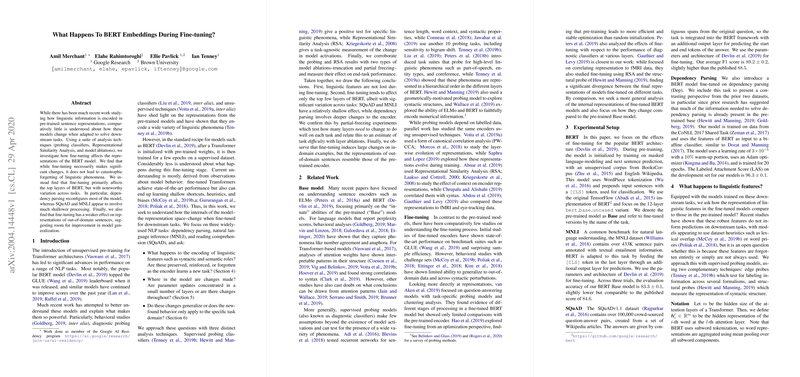Examination of BERT Embeddings During Fine-Tuning
This paper seeks to elucidate the effects of fine-tuning on BERT embeddings, a crucial topic given BERT's ubiquitous application across diverse NLP tasks. Despite the known prowess of models fine-tuned from BERT for specific tasks, the internal changes that occur during this process are not well understood. This paper utilizes probing classifiers, Representational Similarity Analysis (RSA), and model ablations to explore these changes.
The research primarily aims to address three questions:
- The retention of linguistic features such as syntax and semantics through fine-tuning.
- The specific model layers affected by fine-tuning.
- The generalization of these changes beyond the particular task's domain.
Probing Linguistic Representation
Employing both edge probing and structural probing approaches, the researchers investigate the preservation of linguistic features post-fine-tuning. Edge probing showed minimal degradation across a range of tasks, such as POS tagging, constituents detection, and coreference resolution, indicating that BERT retains significant linguistic information even after fine-tuning. Specifically, only small decreases in performance metrics were noted, suggesting the absence of catastrophic forgetting. Structural probing further substantiated these findings, showing that BERT's pre-trained syntactic capabilities endure with negligible impact even after fine-tuning for tasks like MNLI and SQuAD.
Layer-specific Changes
RSA was used to examine BERT layer alterations during fine-tuning for three tasks: MNLI, SQuAD, and dependency parsing. Changes were predominantly concentrated in the top layers, implying that fine-tuning exerts shallow modifications within the network. Notably, the depth of impact varied by task; dependency parsing induced more profound layer modifications compared to the more surface-level alterations seen in MNLI and SQuAD. This suggests that tasks that inherently require deeper linguistic processing tend to affect a broader swath of the model than those conducive to heuristic-based solutions.
For empirical support, layer ablation studies were conducted. The freezing of lower layers resulted in depreciation of accuracy only when the unfrozen portion of the model was reduced to the top-most few layers. Once again, dependency parsing necessitated a broader range of unfrozen layers compared to MNLI and SQuAD, emphasizing the former's requirement for a deeper processing approach.
Generalization across Domains
Lastly, the paper probed the extent of fine-tuning's domain-specificity using RSA comparisons on in-domain and out-of-domain datasets. In both MNLI and SQuAD, RSA showed more profound representational deviations from the base model for in-domain data as opposed to out-of-domain data like Wikipedia text. This suggests that fine-tuning predominantly modifies sentence representations tailored to the task domain and that representations for pre-training contexts remain relatively unchanged.
Implications and Future Directions
This paper illustrates that while fine-tuning brings about considerable performance improvements, the adjustments are localized to the later layers, potentially leaving room for innovative techniques that could utilize this latent capacity more effectively. Additionally, the observed domain-specificity indicates a potential avenue for enhancing model generalization, ensuring improved outcomes across domain boundaries. There are tangible opportunities to refine model adaptation strategies to leverage more complete model potential and optimize task transfer.
In conclusion, this research contributes valuable insights into the internal mechanics of BERT fine-tuning, delineating how representations are altered across tasks and the extent to which these changes remain task or domain-constrained. It paves the way for further exploration into optimizing the fine-tuning process, potentially impacting the development of more versatile NLP systems.
